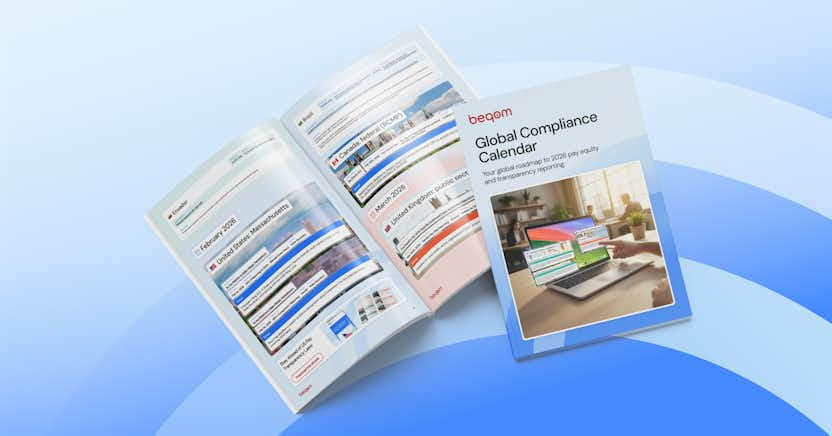Compensation Trends: Diversity, Equity, and Inclusion

Learn more about the following beqom products
In this and coming blogs we will look at some of the hot topics in compensation for 2022 and beyond, and perhaps no subject is more relevant than diversity, equity, and inclusion (DE&I).
As societies change, companies generally benefit from changing with them, in order to stay attuned to the culture and their potential customer base and to attract and motivate talent across an increasingly diverse workforce. Addressing DE&I is one way that companies stay relevant and competitive. So, what role can compensation play in helping companies achieve DE&I objectives?
What do we mean by DE&I in the workplace?
First, let’s give a simple definition for each of the DE&I terms:
Diversity means recognizing that the workforce is made up of all sorts of people, who may have differences in terms of age, race, ethnicity, socio-economic status, able-bodiedness, gender, gender identity, or sexual orientation.
Equity refers to ensuring that everyone is treated fairly and impartially, regardless of the above factors, both as a matter of policy and in actual outcomes.
Inclusion means ensuring that all employees feel a sense of belonging in the workplace as their authentic selves.
Why is DE&I important?
In a survey by Workable of US & Canadian HR professionals, 50.8% felt that respecting DE&I was a moral obligation-–the right thing to do—and that was their top motivator for considering DE&I. But close behind that was the reasoning that DE&I is important for talent attraction, engagement, and retention (47.6%), and meeting employee expectations (47.6%). Other reasons given included business benefits (like revenue and productivity), company reputation, and social, customer, and market expectations.
Allowing people to be themselves and feel safe in the workplace, not surprisingly, yields positive business results. According to a 2018 report by Bersin and Deloitte, organizations with inclusive cultures are 2x as likely to meet or exceed financial targets, 6x more likely to be innovative and agile, and 8x more likely to achieve better business outcomes.
What is the goal of DE&I?
If DE&I is important, what exactly are companies trying to achieve?
One measure is racial and ethnic diversity in the workforce and/or in management. The goal is generally to have the employee population reflect the makeup of the general population, such that no one group is underrepresented. The target groups in the US are sometimes referred to as BIPOC—black, indigenous, and people of color, as these are the groups that are often underrepresented.
Another measure is gender equality, ensuring that women of equal qualifications are at par with men in hiring, promotions, and pay. This is not only a matter of policy but of having systems in place to identify and remedy the problem.
And then there is fairness in relation to sexual orientation and gender identity, which means not discriminating based on those factors, and beyond that, fostering a culture of inclusion. Inclusion is a matter of culture, which starts with leadership but may include initiatives like diversity training which can be measured and tracked.
Many companies find Employee Resource Groups (ERGs) to be an effective means of supporting diversity, inclusion, and engagement for underrepresented groups of employees. ERGs are employer-recognized workplace groups, led by employees, that allow employees with commonalities to support each other and share resources. According to Indeed, “Having Employee Resource Groups at your business can help employees feel more supported and encourage them to stay with your company longer. Happy employees who have the resources to overcome challenges may feel more invested in their work and envision a future with your company instead of looking for employment elsewhere.”
As compensation consulting firm Semler Brossy notes in the article Using Compensation to Promote Diversity, Equity, and Inclusion, “Implementing a DE&I metric may not be appropriate at this time for every company; however, if thoughtfully designed, doing so could create strong alignment with a company’s strategy and initiatives.”
They all boil down to, first, not discriminating against any particular group, but also making an effort to make sure each group has representation and is treated in a fair, equitable, and welcoming manner. This requires first getting an accurate assessment of the situation at your company by analyzing your data on people and pay, then deciding where you want to be and how to get there.
Is DE&I trending?
Clearly yes. In the Workable study, the majority of those surveyed cited an active level of interest in DE&I, with nearly two-thirds of respondents (63%) saying they have some initiatives in place or that DE&I is a permanent part of their company’s overall mission/vision/values. An additional 18.3% said they started considering DE&I in 2020, and 5.3% say DE&I will be a consideration going forward – meaning nearly one quarter of respondents in total (23.6%) are now taking note of DE&I where they weren’t prior to 2020.
What role does compensation play?
Compensation plays a key role in promoting DE&I, in two ways.
First, to treat fairly is to pay fairly. That means not only having fair pay policies but doing the work to analyze whether or not you are in fact paying equitably. Your data can tell the story if you mine it in the right way, for example, controlling for variables other than gender to see if you in fact have a hidden gender pay gap. You can also measure your pay against industry and competitor benchmarks to see how you stack up. The analysis just might pay off by preventing unwanted attrition and boosting your employer brand.
Second, your rewards system can incentivize behaviors that support the corporate strategy. For example, executive compensation can be tied to balanced scorecard measures that reflect DE&I goals. Managers can have performance measures related to diversity and employees at all levels can participate in appropriate training and activities.
Supporting DE&I requires executive leadership, but also needs the right technology in place to make it a reality. A flexible total compensation platform can support companies in ensuring they are paying fairly and rewarding the behaviors that will lead to the successful execution of company strategy.







